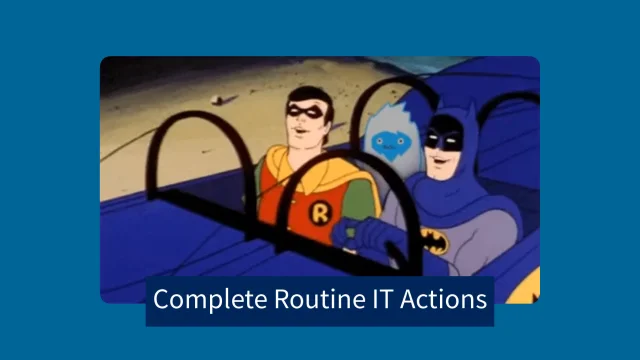Imagine Batman without remote access and monitoring tools. I bet you can’t. Remote access and monitoring are key features in the Bat Mobile and the Bat Cave, allowing Batman to access data and manipulate machines to fight crimes. In the IT service desk, this technology also allows you to problem solve like Batman, albeit with less violence.
This week, we’re looking at 5 use cases for remote access and monitoring software, and how your service desk superheroes can harness its power.
What is Remote Access and Monitoring Software?
When you think of remote access software, what comes to mind is probably IT asking to log onto your computer from a remote desktop software to fix a problem (not a very Batman move). In this scenario, it’s only desktop or laptop computers that can be repaired and, in general, it comes with a clunky and slow interface. But, remote monitoring and access software is actually so much more than that.
The technical definition of remote access and monitoring software, also known as remote IT management, is a type of software designed to help managed IT service providers (MSPs) remotely and proactively monitor endpoints, networks, and computers.
Remote access software allows you to access a user’s computer without interrupting their normal workflow to resolve incidents and problems. For example, you can use this software to check someone’s task manager to kill broken applications without needing full access to their computer in a way that interrupts their ability to keep working.
But, to become as proactive as Batman, you need the predictive side of IT monitoring software to work in conjunction with endpoint management. By that, we mean using a software that creates a 360-degree view of all IT infrastructure and endpoints through AIOps that runs data through an algorithm to predict downtime and proactively prevent an issue before it can arise.
If this were being used by Batman, you might see him monitor the IT/IoT of Gotham City to figure out which software the Joker or the Riddler had created bugs in or to squash problems in impacting a connection of devices. He’d then use the remote access side to hop into the city’s computers to patch the bug or run an update that blocks it.
Core Benefits of remote access and monitoring
There are a few major benefits worth noting when it comes to remote access and monitoring:
- You can improve KPIs at the service desk including ticket resolution time by as much as 30%.
- You’ll see improvements in a metric called Interrupted User Minutes (IUM) which refers to the average lost work time due to incidents or downtime. Improving this score directly relates to better productivity and business outcomes. This directly relates to decreasing lost revenue from IT events.
- Your team will be the type of superhero everyone loves: the kind that is so good at their jobs that people don’t think the problems exist.
Of course, cost optimization, productivity, and feeling like a superhero are all great for the team. But what about the benefits for the powers that be (like the CIO)? The CIO will see not only a happier and calmer workforce, but a more streamlined one that can focus on adding value to the business as a whole, rather than constantly being caught up in the daily firefighting.

5 Business Uses for Remote Access and Monitoring Software
Now you know how Batman would use remote access and monitoring software, and you know why any service desk superhero should use it. But the big question is: how? Answering the “how” can help you decide if this technology is right for you.
1. Pushing Updates to Users’ Computers
We’ve all worked with that person. The person who has a pending software or OS update but still constantly clicks “Ignore” or “Remind me again tomorrow” every. Single. Time.
We love the customers of the service desk, but to an IT person, the customer who refuses updates is kind of like a supervillain who doesn’t know they’re a supervillain. The Mr. Freeze of service desk because without updates they can freeze their productivity. That’s because keeping software up-to-date is crucial in preventing downtime, fixing bugs, and improving cybersecurity.
However, if you use remote access and monitoring software, you can covertly push updates, protecting the IT service desk as if it were your own personal Gotham City.
2. Predict and React to Problems Proactively
We mentioned previously that this technology can create a more proactive IT environment, but let’s think about this in a more practical way. Let’s say you’re trying to battle the Joker (i.e., incidents that are all connected between users in a specific department that seem to evade you at every turn.) You’ve tried to implement automation to help you figure out what is going on, but now the human element has to step in. You need to look at everyone’s computer in that department and find common links to the problem and, hopefully, stop the problem from impacting users who haven’t yet reported it.
Remote access and monitoring software can allow you to observe and essentially reach into the hardware of the teams being affected to look for links and connections, and then fix them. The user won’t know that you’re basically doing Batman moves on their computers, but you can stop a problem in its tracks.
3. Complete Routine IT Actions
As much as we push the idea of shift-left through self-help technology, there are some routine actions that may still need human intervention. These simple actions might be difficult to explain to the service desk customer, and remote access technology can help you complete these actions on their behalf.
Especially helpful in a remote work landscape, some of these routine actions include:
- Installing a driver or device
- Adding and troubleshooting a printer
- Mapping a drive
- Installing or repairing a software
- Monitoring performance
4. Monitor IT Infrastructure and Endpoints
Remote monitoring of your IT infrastructure and endpoints can help you untangle the web of frustration when trying to pinpoint where or when a software stopped working properly. Think of it as a trap laid by The Riddler – using your remote monitoring superpowers, you can see the entire forecast of the infrastructure to solve the riddle faster. Then, using the remote access component, you can solve that riddle.
Think of this aspect as the interactive map in the Batmobile that tells Batman where to go in Gotham to solve the crime. This is another key component of proactive IT that often goes unappreciated, but is a game changer that creates faster resolution in the background.
5. Background Systems Management Tasks
Not only does remote access and monitoring software allow you to take over routine tasks, it also can give you a faster approach to systems management tasks.
For example, you can remotely handle:
- Global configuration management
- Real-time monitoring, reporting and process automation
- Software deployment, patch management and Windows updates
- Remote control, SSH and Telnet access
- Secure access of desktops, servers, switches, and firewalls
- Active Directory administration and automation
- Bulk actions performed in 1 click
- Hardware & Software inventories
- User’s activities monitoring
In other words, you can be like Alfred, Batman, and Robin all rolled into one for these systems tasks.
Conclusion
Ready to find out how EasyVista can help you move your Bat Cave to an efficient model without sacrificing service quality? Talk to our team to find out more!


